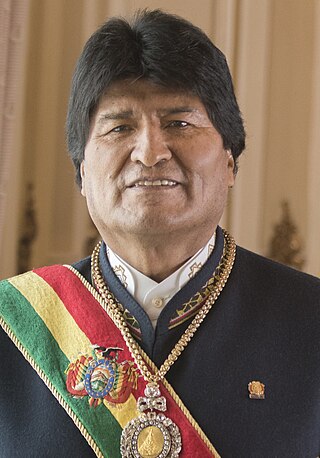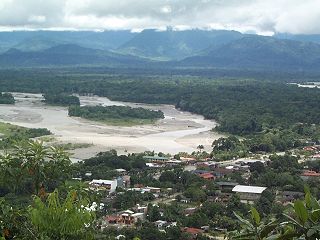
Bolivia, officially the Plurinational State of Bolivia, is a landlocked country located in western-central South America. It is bordered by Brazil to the north and east, Paraguay to the southeast, Argentina to the south, Chile to the southwest, and Peru to the west. The seat of government and administrative capital is La Paz, which contains the executive, legislative, and electoral branches of government, while the constitutional capital is Sucre, the seat of the judiciary. The largest city and principal industrial center is Santa Cruz de la Sierra, located on the Llanos Orientales, a mostly flat region in the east of the country.

Juan Evo Morales Ayma is a Bolivian politician, trade union organizer, and former cocalero activist who served as the 65th president of Bolivia from 2006 to 2019. Widely regarded as the country's first president to come from its indigenous population, his administration worked towards the implementation of left-wing policies, focusing on the legal protections and socioeconomic conditions of Bolivia's previously marginalized indigenous population and combating the political influence of the United States and resource-extracting multinational corporations. Ideologically a socialist, he has led the Movement for Socialism (MAS) party since 1998.

Cochabamba, from Quechua qucha or qhucha, meaning "lake", pampa meaning "plain", is one of the nine departments of Bolivia. It is known to be the "granary" of the country because of its variety of agricultural products from its geographical position. It has an area of 55,631 km2. Its population in the 2012 census was 1,758,143. Its capital is the city of Cochabamba, known as the "City of Eternal Spring" and "The Garden City" because of its spring-like temperatures all year.

Cochabamba is a city and municipality in central Bolivia in a valley in the Andes mountain range. It is the capital of the Cochabamba Department and the fourth largest city in Bolivia, with a population of 630,587 according to the 2012 Bolivian census. Its name is from a compound of the Quechua words qucha "lake" and pampa, "open plain." Residents of the city and the surrounding areas are commonly referred to as cochalas or, more formally, cochabambinos.

Chapare (Spanish:[tʃaˈpaɾe], also called The Chapare, is a rural province in the northern region of Cochabamba Department in central Bolivia. The majority of the territory consists of valley rainforests that surround the area's main waterway, the Chapare River, which is also a tributary of the Amazon River. The provincial capital is Sacaba, 11 km east of Cochabamba. Its principal town is Villa Tunari, a popular tourist destination.

The Movement for Socialism, officially the Movement for Socialism – Political Instrument for the Sovereignty of the Peoples, is a socialist political party in Bolivia. Its followers are known as Masistas.

Quillacollo is the capital of Quillacollo Province in Cochabamba Department, Bolivia. The municipality was established on 14 September 1905 under the Presidency of Ismail Montes.

Cocaleros are the coca leaf growers of Peru and Bolivia. In response to U.S.-funded attempts to eradicate and fumigate coca crops in the Chapare region of Bolivia, cocaleros joined with other grassroots indigenous organizations in the country, such as unionized mine workers and peasants to contest the government. Evo Morales, who became president of Bolivia in 2006, was a leader of the cocalero movement in that country.
Social unrest in Cochabamba involved violent clashes between supporters and opponents of Cochabamba Prefect Manfred Reyes Villa in the departmental capital city of Cochabamba, Bolivia, reaching their peak on January 11 and 12, 2007. The policies of the President Evo Morales and the agenda of his Movement towards Socialism (MAS) party in the Constituent Assembly were opposed by politicians in other political parties, notably Reyes Villa. The prefect's opposition to Morales' policies angered the President's supporters, and early in 2007 demonstrations in Cochabamba escalated into violent clashes between Reyes Villa's civic movement and urban and rural social movements who called for his ouster. During the violence, coca farmer Juan Tica Colque and the young student Christian Urresti (17) were killed. Coca farmer Luciano Colque (48) was mortally wounded by blows from civic movement protesters and died of cranial trauma on February 27. Some 200 people were wounded in the clashes.

Bolivia–United States relations were established in 1837 with the first ambassadorial visit from the United States to Peru–Bolivian Confederation. The Confederation dissolved in 1839, and bilateral relations did not occur until 1848 when the United States recognized Bolivia as a sovereign state and appointed John Appleton as the Chargé d'Affaires.

The domestic policy of the Evo Morales administration refers to the domestic policy initiatives of the former President of Bolivia, including past pre-presidential advocacies by Morales.

Cliza is a small town in the Cochabamba Department, Bolivia. It is the capital of the Germán Jordán Province and the Cliza Municipality. Along with Punata, Cliza is the major city in the valle alto of the Cochabamba Department.
Cotagaita is a small town in Bolivia. In 2009 it had an estimated population of 1904.
The Villa Tunari Massacre was a 27 June 1988 mass murder committed by UMOPAR troops in response to a protest by coca-growing peasants (cocaleros) in the town of Villa Tunari in Chapare Province, Bolivia. The cocalero movement had mobilized since late May 1988 in opposition to coca eradication under Law 1008, then on the verge of becoming law. According to video evidence and a joint church-labor investigative commission, UMOPAR opened fired on unarmed protesters, at least two of whom were fatally shot, and many of whom fled to their deaths over a steep drop into the San Mateo River. The police violence caused the deaths of 9 to 12 civilian protesters, including three whose bodies were never found, and injured over a hundred. The killings were followed by further state violence in Villa Tunari, Sinahota, Ivirgarzama, and elsewhere in the region, including machine gun fire, beatings, and arrests.
Narcotics in Bolivia, South America, is a subject that primarily involves the coca crop, used in the production of the drug, cocaine. Trafficking and corruption have been two of the most prominent negative side-effects of the illicit narcotics trade in Bolivia and the country's government has engaged in negotiations with the United States (US) as result of the industry's ramifications.

Coca has been cultivated in medium-altitude parts of the Bolivian Andes since at least the Inca era, primarily in the Yungas north and east of La Paz. Cultivation expanded substantially in the 1980s into the Chapare region of Cochabamba and some production flowed into the international cocaine market. The US-backed efforts to criminalize and eradicate coca as part of the War on Drugs were met by the cocalero movement's growing capacity to organize. Violence between drug police and the Bolivian armed forces on one side and the movement on the other occurred episodically between 1987 and 2003. The cocaleros became an increasingly important political force during this period, co-founding the Movement for Socialism – Political Instrument for the Sovereignty of the Peoples party. Coca growers from both the Yungas and the Chapare have advocated for policies of "social control" over coca growing, maintaining a pre-set maximum area of cultivation as an alternative to drug war policies. In 2005, cocalero union leader Evo Morales was elected president of Bolivia. Morales has pursued a combined policy of legalizing coca production in the Chapare and Yungas and eradication of the crop elsewhere.
Jorge Ledezma Cornejo is a Bolivian lawyer and politician affiliated with the Movement towards Socialism–Political Instrument for the Sovereignty of the Peoples. Ledezma served as a Deputy in the lower house of the Bolivian National Congress, representing circumscription 28, and as interim prefect of Cochabamba from December 2008 until 30 May 2010. He is currently Bolivia's ambassador to Peru. His career began as vice president of Cochabamba's Departmental Irrigation Users Federation in 1997; leader of the Mega (Sacaba) Association of Irrigation Users in 1998; and president of the Vigilance Committee of the Municipality of Sacaba in 1998. He then won public office as a councilman in Sacaba in 1999, followed by serving as the city's mayor in 2000-2001. His appointment to Prefect of Cochabamba was made by President Evo Morales following the 100-day tenure of Rafael Puente; the reasons for Puente's replacement are disputed.

Indigenous peoples in Bolivia, or Native Bolivians, are Bolivian people who are of indigenous ancestry. They constitute anywhere from 40 to 70% of Bolivia's population of 11,306,341, depending on different estimates, and belong to 36 recognized ethnic groups. Aymara and Quechua are the largest groups. The geography of Bolivia includes the Andes, the Gran Chaco, and the Amazon Rainforest.
The Chapare Drug Cartel is a Bolivian criminal organization dedicated to drug trafficking and human trafficking that operates in the Chapare region. For this, several journalists have baptized this organization simply as the Chapare Cartel
The 2019 Sacaba massacre occurred when Bolivian soldiers and police attacked and broke up a protest led by Bolivian coca growers at Huayllani in Sacaba municipality, Cochabamba on 15 November 2019. It came in the first week of the interim presidency of Jeanine Áñez. Marchers intended to enter the town of Sacaba and proceed to the departmental capital of Cochabamba to protest the ousting of Bolivian president Evo Morales, but were stopped by the police and military. During the afternoon, police and soldiers clashed with protesters, and eventually soldiers opened fire on the crowd. Eleven demonstrators were killed; an estimated ninety-eight people were wounded, including four journalists and eight members of the security forces. Two hundred twenty-three protesters were arrested, many of whom suffered mistreatment and at least nine of whom were tortured.
















